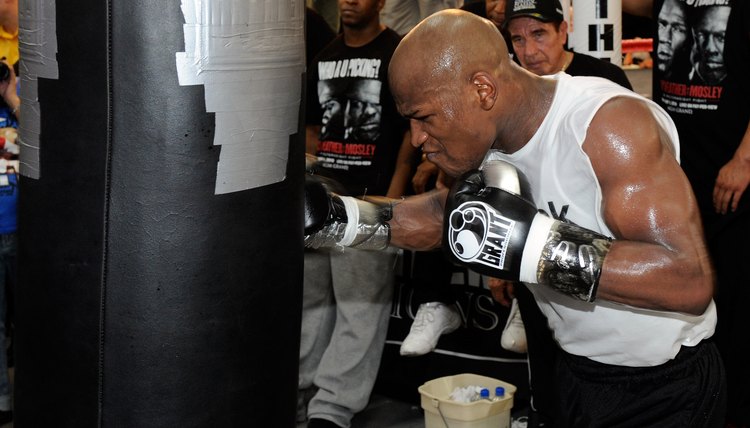The Best Way to Hang a Heavy Bag

Training for any type of contact sport such as boxing or martial arts is enhanced with heavy bag workouts. Made of leather and filled with sand or water, the bags simulate realistic resistance when hit, giving experience similar to training with a human partner. The design makes heavy bags difficult to install correctly, because the mount needs to support the weight of the bag -- usually 50 to 150 pounds -- as well as hold up under the force of the hits it receives.
Ceiling Mount
Attaching a mounting bracket to the ceiling is the preferred way of installing a heavy bag in a gym or workout room. The free motion allowed by a ceiling mount provides the most realistic interaction between the bag and the person training with it. Ceiling mounts aren't a great idea when they're not being used in a professional setting, where the structure would typically be more substantial than in a private home. If, for instance, you want to install one in your spare bedroom by attaching the mount to ceiling joints or rafters, you could end up destroying your ceiling one punch at a time with the jarring vibrations. Unless you have oversize timbers, reinforced rafters or diagonal bracing in the framework, using a mount other than a ceiling mount would be a better choice.
Wall Mount
Wall mounts are practical alternatives to ceiling mounts, but only if you aren't installing them on drywall or plywood walls. Wall mounts work best on cement walls, so you don't run into the problem of structural damage from the repetitive jarring when punching the bag. Wall mounts are installed by screwing the bracket into place close to the top of the wall where it meets the ceiling. The heavy bag is attached to a long arm at the top of the bracket; some models are modified so you can swing the arm to the side, placing the bag out of the way when you're not using it.
Floor Stand
If the structure of your room won't accommodate hanging a heavy bag from the ceiling or the wall, a floor stand might be the solution. Made from welded metal tubing, floor stands typically are about 7 1/2 feet high and 4 feet wide. Secure a floor stand to the floor so it doesn't move or tip while you work out. It will take up some floor space, but since a floor stand allows you to hang the heavy bag from the top and not close to walls that might interfere with free motion, you'll still get the results and workout you would from a ceiling mounted bag.
Free Standing
If everything in your workout room is at odds with installing a heavy bag--two by four ceiling joints, drywall based walls, no floor space for a floor stand--then a freestanding heavy bag is the only way to go. They don't quite give the same simulated movement that a hanging bag does, but freestanding heavy bags still react with realistic movement and you won't have to drill holes in the walls or the ceiling. Freestanding bags are easily moved, too, so you can work out in different locations in or around your home whenever you feel the need and then easily store it out of the way when you're finished.
A Professional's Opinion
At the request of members of his health club who box or practice jujitsu and other martial arts, Matt Siaperas installed a heavy bag in an unused corner of a basement aerobics room. "I thought of the basement first because there are some really sturdy beams in the ceiling down there and I knew the guys would want the bag hung from the ceiling," he said. Because it could hang securely from the ceiling, Siaperas didn't have to consider accessories such as adding a spring to the bracket where the bag's chain connects to the mount, or securing it to the floor with a bungee cord. A spring can help minimize vibrations that can affect the structure of the room, but often the spring causes the heavy bag to bounce and jump in an unnatural way. Adding a bungee cord to the bottom of a heavy bag when using a spring will stop the bouncing and will keep it from swinging too much. Less swinging can be positive or negative, depending on whether your bag is heavy enough to take your punches. If it is too light, the bungee cord would be a helpful addition.
References
- Matt Siaperas, health club owner; Hardbodies Gym; Blackfoot, Idaho
- "Knockout Fitness: Boxing Workouts to Get You in the Best Shape of Your Life": Andy Dumas, Jamie Dumas
- "Boxing For Beginners: A Guide To Competition & Fitness": Billy Finnegan, Courtney Clark
- Heavyfists: Don't Let Your Heavybag Shake Your House Apart
- Mixed Martial Arts of MMA: Free Standing Punching Bags
Writer Bio
Elle Di Jensen has been a writer and editor since 1990. She began working in the fitness industry in 1987, and her experience includes editing and publishing a workout manual. She has an extended family of pets, including special needs animals. Jensen attended Idaho and Boise State Universities. Her work has appeared in various print and online publications.
